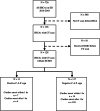Contrast Agent Pooling (C.A.P.) sign and imminent cardiac arrest: a retrospective study
- PMID: 35524167
- PMCID: PMC9074346
- DOI: 10.1186/s12873-022-00634-4
Contrast Agent Pooling (C.A.P.) sign and imminent cardiac arrest: a retrospective study
Abstract
Background: The sign of contrast agent pooling (C.A.P.) in dependent part of the venous system were reported in some case reports, which happened in the patients before sudden cardiac arrest. Until now, there is no solid evidence enough to address the importance of the sign. This study aimed to assess the accuracy of the C.A.P. sign in predicting imminent cardiac arrest and the association of the C.A.P. sign with patient's survival.
Methods: This is a retrospective cohort study. The study included all patients who visited the emergency department, who received contrast computed tomography (CT) scan and then experienced cardiac arrest at the emergency department (from January 1, 2016 to December 31, 2018). We evaluated the occurrence of the C.A.P. sign on the chest or abdominal CT scan, patients with ECMO were excluded. With positive C.A.P. sign, the primary outcome is whether in-hospital cardiac arrest happens within an hour; the accuracy of C.A.P. sign was calculated. The secondary outcome is survival to discharge.
Results: In the study, 128 patients were included. 8.6% (N = 11) patients had positive C.A.P. sign and 91.4% (N = 117) patients did not. The accuracy of C.A.P. sign in predicting cardiac arrest within 1 h was 85.94%. The C.A.P. sign had a positive association with IHCA within 1 h after the CT scan (adjusted odds ratio 7.35, 95% confidence interval [CI] 1.27 - 42.69). The relative risk (RR) of survival to discharge was 0.90 with positive C.A.P. sign (95% CI 0.85 - 0.96).
Conclusions: The C.A.P. sign can be considered as an alarm for imminent cardiac arrest and poor prognosis. The patients with positive C.A.P. sign were more likely to experience imminent cardiac arrest; in contrast, less likely to survive.
Trial registration: IRB No.108107-E.
Keywords: Cardiac failure; Emergency medicine; Radiology; Resuscitation; Shock.
© 2022. The Author(s).
Conflict of interest statement
The authors declare that they have no competing interests.
Figures



References
-
- Graham R, McCoy M, Schultz A. Strategies to Improve Cardiac Arrest Survival: a time to act. Washington (DC): National Academies Press (US); 2015. - PubMed
-
- Hong SH, Kang EY, Huh S, Yong HS, Kim YK, Woo OH, et al. Emergent CT findings of impending cardiac arrest: a report of 4 cases. Am J Emerg Med. 2013;31:637.e3–637.e6. - PubMed
MeSH terms
Substances
LinkOut - more resources
Full Text Sources
Medical

